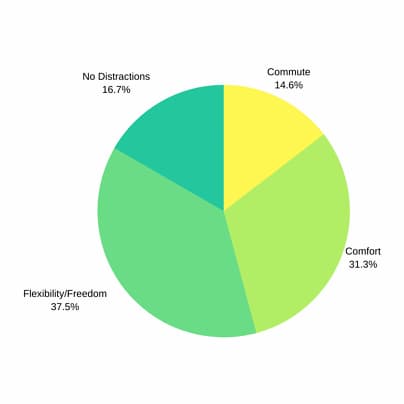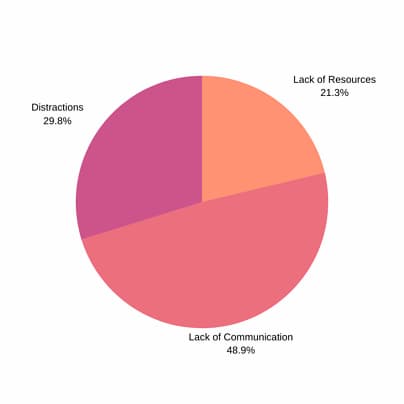What Employees Want You to Know about Their Remote Work Experience

Start Making More Calls Today
Not sure which solution would be the best fit for your needs? We can work with you to find a solution that’s right for your business.
get a free quoteAn independent survey shows the effects of remote work on employee productivity and satisfaction.
A Nationwide Transition to Home Offices
According to the Bureau of Labor Statistics, in 2018, only 29 percent of Americans could work from home, including one in 20 service workers and more than half of information workers.
Though there is no hard data for how many employees are working from home in April 2020, as opposed to say, February 2020, it’s safe to say the number of remote employees has jumped dramatically.
“The coronavirus is putting remote work to a gigantic test,” states an article by NPR. Throughout China, Italy, Japan, South Korea, and now, the U.S., workers have been on lockdown due to the worldwide COVID-19 pandemic.
Employees who have never considered turning their homes into an office, alongside employees who have always dreamed of the freedom to work from home, are now left with no choice but to make the adjustment to working from home.
Remote work was once considered a tool for recruiting and retaining top talent – a nice perk for when your car breaks down or you’re snowed in and can’t make it to work. Now, it is a mandate in some states and growing in popularity for most states.
(If you are looking for tips for transitioning out of the office, we’ve created guides for both the debt collection industry and more traditional small businesses.)
According to TIME magazine, Zoom, the video meeting software company, saw its share price nearly double over the past month and was the most downloaded app on Apple’s iOS in March. Microsoft Teams, which lets workers video chat, message, and share documents, has seen a 500 percent uptick in the number of meetings, calls, and conferences over Teams in China since January 31.
We wanted to find out what exactly changes when a workforce transitions from an office to their homes. In order to do so, we created a short survey that we distributed throughout our own networks, with responses remaining anonymous.
In this blog, we want to share the data we recently uncovered from more than 60 professionals who shared what their working from home experience has been like.
"How's It Going Working from Home?" Survey Data and Conclusions
Question 1: What is Your Favorite Thing About Working from Home?
We organized the responses to this question into four categories: Fewer distractions, no commute, comfort, and freedom.

It was important to us to distinguish “comfort” from “freedom,” though they might seem similar. This was because, to us, the response “Pants Optional!” felt different from “Flexibility while also maintaining or increasing productivity.”
These responses were overall unsurprising. Prior to this pandemic, many everyday employees (myself included) had the preconception that working from home would take away the headache of traffic, unwelcome interruptions in the office, uncomfortable shoes, and the ability to step away from your “desk” to pick up a prescription or meet one’s child at the school bus in the afternoon.
But as we continued to see responses to the following questions come in, we were surprised at how the pros of remote work didn’t seem to outweigh the cons.
Question 2: What is Your Least Favorite Thing about Working from Home?
These responses were organized into three categories: Too many distractions, a lack of resources (such as a reliable computer, desk space or Wi-Fi) and lack of communication.

This answer gives us insight into what the biggest adjustment is for employees who are newly remote. What is a perk for some (no distractions) is a challenge for others (more distractions.)
Nearly half of respondents shared the most common frustration was a lack of communication – sitting above a lack of resources and distractions.
Question 3: What Do You Miss About Working in the Office?

We wanted to find out what was most obviously missing for newly remote employees. By a long shot, we found that employees sorely missed the ease of communication that comes with being in an office.
With multiple responses like this: “The ability to ask a quick question on the floor, catch up casually with co-workers and get an office tea/snack, etc.” and “Quick impromptu meetings in the hall or at desks,” we quickly realized that the ease of walking over to a coworkers desk is difficult to simulate, even with tools like Slack.
Question 4: What has been the hardest part about transitioning from working in an office to working from home?

We received a lot of responses that sounded like this:
“Never really being able to “shut down” because I literally live at work.”
“Feels like my days are twice as long and harder to stay on task.”
“Focusing and adapting my brain to work from home. Before I only worked from home in limited capacities and kept everything pretty separate in my mind.”
The mental adjustment of working from home accounted for 47 percent of responses. Coming in a close second were responses having to do with the actual work environment – people reporting that the physical space of an office aided in their productivity and satisfaction.
Close behind that were employees who said their day to day work life was not so different. Some respondents said they had experience previous experience working from home which aided in their adjustment.
Question 5: What is one initiative your employer has implemented since you've transitioned out of the office that you appreciate? (i.e. happy hours, group chats, communication software) Why do you like it?

We were surprised to see the split for this being relatively even. Looking at whether or not something was implemented vs. nothing at all, was a 65-35 split. For companies that had implemented something, the most common was Zoom and Microsoft Teams.
One respondent said the following: “Meetings are encouraged to be video conferences as opposed to conference calls (audio only). I like the video conferences better because you now can put a face to a voice.”
Presumably, we all know what our co-workers faces look like. But as we continued to observe responses, we found that video calls change the tone and efficiency of a conversation.
In a research study recently published in the Journal of Experimental Social Psychology, it was found that “people tend to overestimate the power of their persuasiveness via text-based communication, and underestimate the power of their persuasiveness via face-to-face communication.”
In another study, it was found that “Internet communication cannot predict quality of life while face-to-face communication with friends and family members can.”
Time and time again, we found research that showed in person communication exceeded the quality of digital communication.
Because so many employees no longer have the option to engage in face to face communication, video chat is the next best thing. Here are a few ways using video can improve communication and satisfaction:
1. Improving Participants’ Level of Engagement
On the whole, it’s easier to talk to someone when you can see their face. When all you can hear is audio, you have no idea if that person is engaged in the conversation. They could be scrolling on their phone or watching Netflix on mute. Being able to see their face keeps both parties engaged in the conversation.
2. Conveying Non-Verbal Cues
Facial expressions, eye contact, arm crossing, stature and dress are still transmitted between users and still communicate underlying emotions and reactions to communication. This makes miscommunication less likely.
3. More Personalized Relationships
Video and web conferencing allows a more personal connection to be made with the other participants. It allows you to attach a name with a face, and brings out other sides of the contributors personality. It’s easier to build a more solid relationship when a deeper, more personal connection can be made and fostered.
When the option to connect face to face is taken away, don’t underestimate the power of connecting with your employees via video on a regular basis. This initiative can have a profound affect on your employees’ engagement, their likelihood to misunderstand or misinterpret work related matters, and their overall connection to your company’s bottom line.
About The Author
Alex Villafranca
Alex is the CEO, co-founder and Head of Revenue at Arbeit, a better outbound communication software that makes businesses more profitable.